The beginning of spring is often signified by the calls of a thousand frogs. A call of hope as winter passes and the warmth of spring begins anew.
Where I come from in Canada, it is typically spring peepers who are the first to call. I love walking outside as dusk turns to twilight when the air is filled with the sound of frogs emerging from their long winter hibernation.
It is peaceful and grounding, reminding me that although change is constant, you can always rely on spring to come.
Let’s explore these fascinating creatures, understand why they are important to have around, learn all about their life cycle, and also find out what they eat.
Importance Of Frogs In The Ecosystem
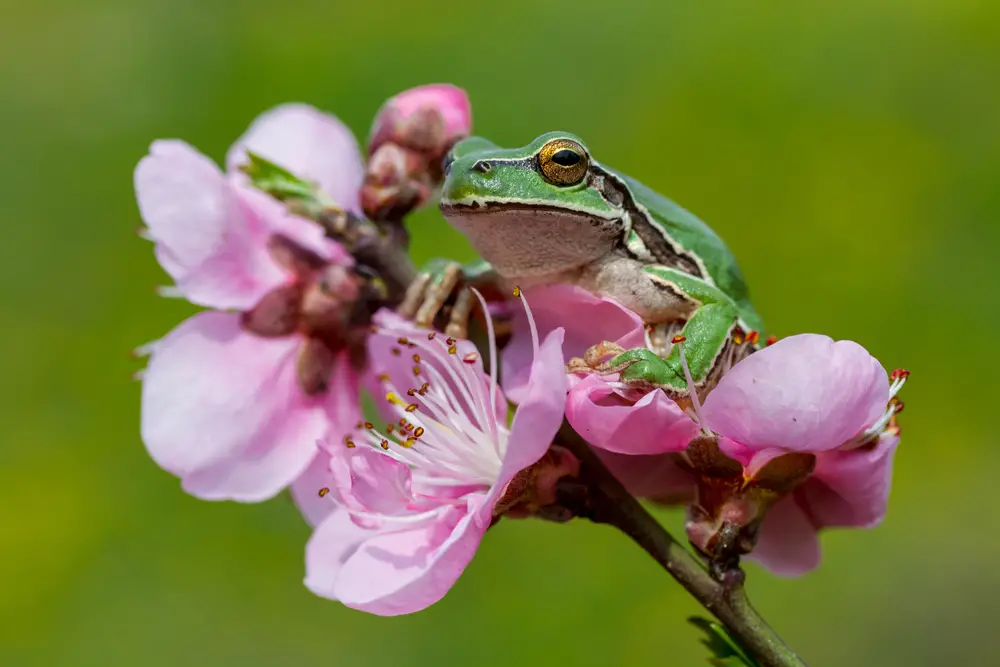
Why Are Frogs Important To The Ecosystem?
Frogs are an integral part of a balanced and healthy ecosystem. They keep insect populations under control – especially mosquitoes and flies. One of their roles is acting as a form of biological pest control by consuming unwanted garden pests that can negatively impact agricultural crops.
They are considered an indicator species. This means that their populations mirror the health of the ecosystem they reside in. For example, if frogs are abundant, the ecosystem is healthy. In turn, if frogs are scarce, it means that the habitat’s health may be in decline.
They act as a food source for other animals like birds and snakes. This contributes to a healthy ecosystem as they support predators higher up in the food chain.
Frogs are an important part of creating a biodiverse landscape.
Frog Species And Habitats
Frogs and toads belong to the Order Anura. “True frogs” are in the family Ranidae. Toads belong to the family Bufonidae.
Frogs are long-lived organisms. For over 200 million years frogs have been on earth! They are a primitive species and haven’t changed too much in the millions of years they have been around.
Their life span is unknown in the wild but they can live over 20 years in captivity.
Frog Species Of North America
There are 2,700 of known frog species in the world. 95 of these species are located in North America. 21 of them are toads.
Some exceptional species that live in North America include:
- Wood Frog
- Northern Chorus Frog
- Pacific Tree Frog
- Spring Peeper
What Is A Frog?
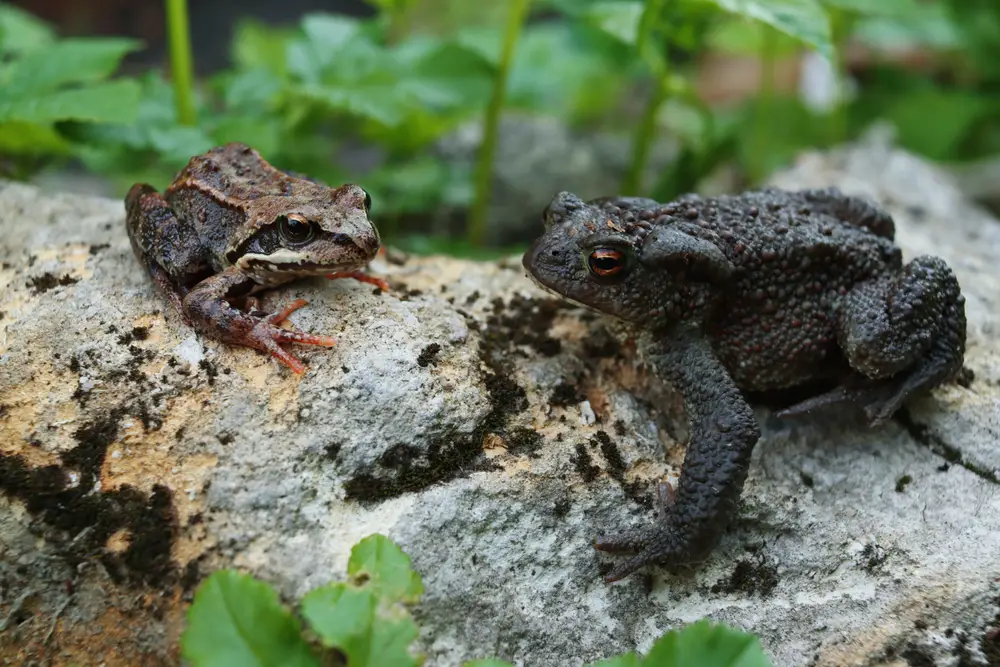
Key Characteristics And Traits
Appearance
the frog’s skin is porous and slimy. This slime is a mucus that aids in keeping their skin moist during hot days. It is also antibacterial and antifungal, so this mucus is necessary for keeping them healthy and safe.
They can breathe through their skin, therefore it is important to maintain moisture and porousness. They also shed their skin from time to time and eat it. This is because their skin is filled with proteins that are nutritious to the frog and keep them healthy.
Frogs have eardrums that are connected to their lungs. This unique characteristic allows them to make loud croaking noises without impacting their hearing. This eardrum is the circle located behind the frog’s eye. This eardrum is called a tympanum. This size of the tympanum is a key indicator when identifying frog species.
They have a long sticky tongue for catching prey like flying insects.
Habitat
They are aquatic or semi-aquatic and live their entire lives in or near water.
This does not include the tree frogs which spent most of their time living high up in the trees.
Metamorphosis
Just like Hilary Duff, they will go through a metamorphosis. They start as aquatic tadpoles with gills and undergo a monumental change into a terrestrial being.
This change is fueled by the tadpole’s thyroid gland.
When the metamorphosis is about to occur, the thyroid releases hormones that initiate the change. We will dive deeper into each stage of development a little further down in this article.
Movement
They have long and lean bodies and legs. This gives them the ability to jump and leap throughout their environment. This characteristic comes in handy for avoiding predators as well as catching prey.
Frog vs. Toad: A Comparative Analysis
As discussed above, they have many key traits that defines them. But what is the difference between a frog and a toad? Frogs and toads have a lot of differences!
Let’s take a deeper look into the differences.
What Is A Frog?
As stated above a frog is long and lean. They are aquatic or semi-aquatic and live their entire lives in or near water. Their porous, slimy skin allows them to breathe through it.
They are nocturnal. This means they are most active at night. They have regal, long legs for hopping, jumping and leaping. They have webbed feet for swimming and sticky toe pads for climbing.
Their long, sticky tongues extend far out of their bodies to catch insects to eat.
What Is A Toad?
A toad, on the other hand, is squat and dumpy in appearance. They are terrestrial beings with warty, tough, dry skin that is not porous. Their warts are parotid glands that secrete a poisonous substance. This substance is a defense mechanism used to protect them from predators.
Toads have short, stout legs. This means that their movements include more walking or crawling rather than leaping and bounding. They do not have webbed feet. Their tongues are short and stay in their mouths.
Frog vs Toad Spawn
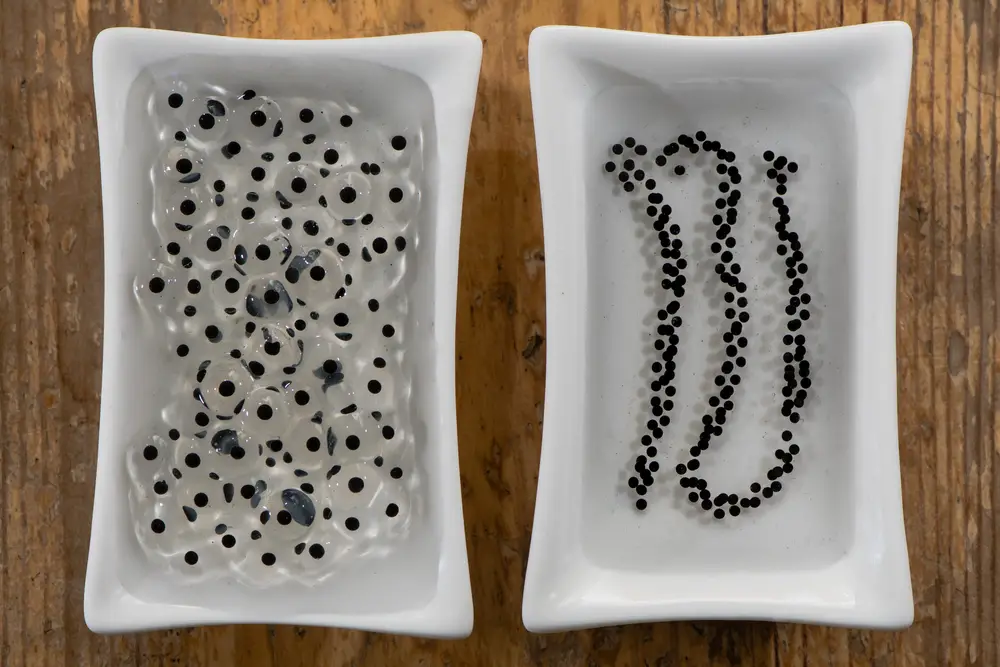
This picture shows the frogs spawn on the left and the toad spawn on the right. Notice the difference in formation.
Frogs lay eggs in an aquatic environment in clusters under lily pads and attached to aquatic plants.
Toads lay their eggs in the string formation. Some species even give birth to baby toadlets. Seeing a mass of toadlets in the spring is a wonderful sight to see!! They hip-hop in the hundreds and are so tiny and cute.
Why This Distinction Matters In Your Garden
When attracting frogs to the garden, knowing the difference between the two is important. For example, aquatic environments are important for frogs. This can look like various-sized ponds.
When you are attracting toads to the garden, creating moist terrestrial environments is important. Leaf litter and shady spots are important for the success of toads in the garden. Toad abodes are also a fun way to invite toads into your space.
Both are beneficial for getting rid of unwanted insects and aid in a thriving biodiverse landscape.
Frog Habitat And Environment

Natural Habitats: Where Do Frogs Live?
In a natural environment, Frogs inhabit freshwater systems. Habitats like wetlands, streams, and rivers.
Across the world, they live in many different ecosystems, including mountain ranges, rainforests, and even desert landscapes.
Although they may live in varying ecosystems, they have one constant:
- They need to be around water bodies and moist environments
These amphibians are very sensitive to environmental changes like drought.
Frogs And Ponds: Importance Of Water Sources
They rely on water sources to survive.
Having a pond will attract and create an ideal environment for them to thrive.
Frog Shelter: Natural And Man-Made Options
If you’ve seen the viral video of the Frodhouse on TikTok, then you know that it is possible to successfully create man-made shelters. These shelters help them stay cool and protect them from predators when out of water.
A natural form of shelter is creating moist environments and a garden with plants for shelter. In the aquatic environment, it looks like aquatic plants like water lilies or a dense patch of cattails. On land, growing plants like hostas and dahlias create a natural sheltered habitat.
The Ecological Role Of Frogs
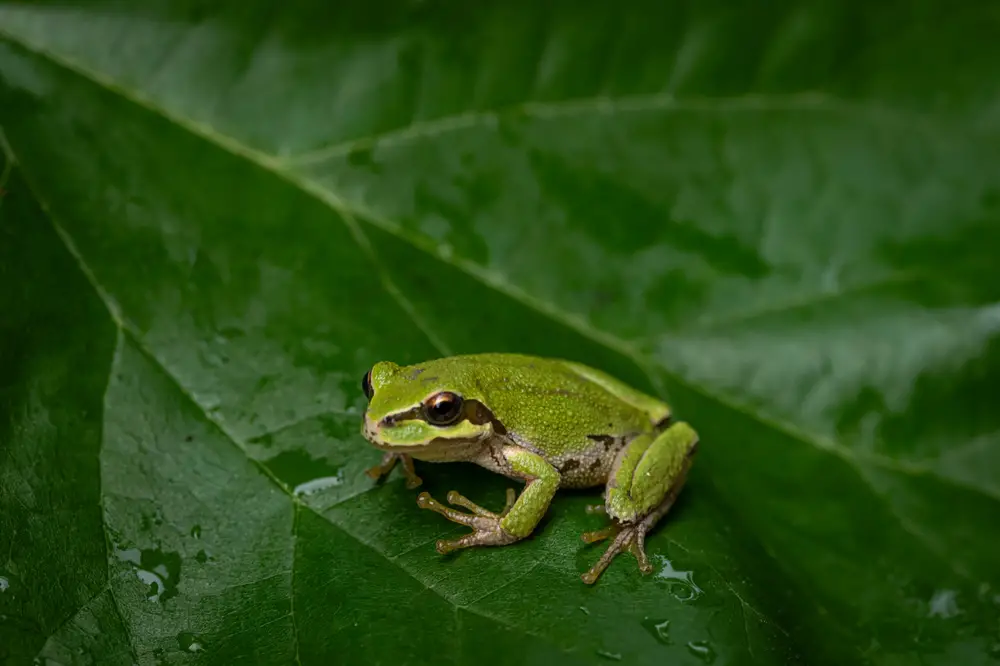
Why Are Frogs Important?
Frogs are an important part of the circle of life and food web in their ecosystems. They are a natural form of pest control as they balance mosquitoes and other insect populations.
Not only do they eat unwanted garden pests, but they are also an important prey species for other bigger animals higher up in the food chain.
Frogs In The Garden: A Sign Of A Healthy Ecosystem
Frogs are considered an indicator species. This means that if their populations are healthy, their ecosystem is healthy too.
Indicator species can also be a barometer of an unhealthy ecosystem. If frogs are scarce in an area they are meant to be thriving, it means that the health of that ecosystem may also be struggling.
That’s why it’s important to keep frogs in the garden! Keep a healthy and sustainable backyard for all the critters on this beautiful planet.
Frog Life Cycle: From Egg To Adult

Hatching And Metamorphosis: A Closer Look
They undergo one of life’s most curious transformations. From egg to tadpole, they live a fully aquatic life.
They then go through a metamorphosis growing legs and extending to life on land. Below, we will go through each stage of their life cycle, gaining a closer and more in-depth look at the stages of metamorphosis.
The Stages Of A Frog’s Life Cycle
Eggs And Tadpoles: Early Life In The Water
As the weather warms and the days get lighter, early spring is a sign for a mother frog to lay her eggs in the pond where she was born. She will lay hundreds of eggs in large clumps under leaf matter or in dense aquatic vegetation.
The eggs are small and once submerged in water they swell with a jelly-like casing. This helps keep the eggs moist and safe as well as aid them to attach to vegetation. These egg masses are called “frogspawn”.
Only 50 or so eggs will make it through to froghood as they are an important food source for other animals in the food chain. Fish and birds enjoy these tasty morsels.
The mother lays her eggs in the same pond that she was born in, and will return year after year to do so. They spend 1-3 weeks in this life stage.
The difference between frog and toad eggs is the shape of the eggs and the form they lay in. Frog eggs are more round and form large clumps. Toad eggs are long and oval in shape. They are distributed in string-like ribbon formations.
Tadpoles To Froglet: The Transformation
Tails and gills develop within the eggs as the tadpole begins to take shape. Once a tadpole emerges from the egg it eats the yolk for added nutrients. Tadpoles are fully aquatic and eat plant material. As they grow and develop they also eat inverts and small insects.
Typically, tadpoles are in this life stage for 14 weeks. Tadpoles can control how long it takes for them to grow into a froglet. If the habitat is unfavorable, they metamorphose quicker than if the environment is relaxed and safe.
If their environment is stable, with abundant food sources, they can delay their transformation by several months. A frog knows that it is not the destination, but the journey. And if tadpole life in the water is the life of luxury, that is where they will stay.
Once they are ready to transform into froglets, their tails start to shrink and they develop legs. Their skin grows over their gills and they develop lungs.
Froglet To Adult Frog: Completing The Cycle
Once the lungs and other internal organs have developed within the tadpole, they can make the transition to land.
As their mouthparts have developed they start eating fish, snails, and worms. As a young froglet, they start to explore their new terrestrial life. They stay close to the water at this stage as they are still quite small and learning the ropes of frog life on land.
It takes up to four years for a froglet to mature into a full adult. Adult size varies from species to species. Some can reach up to 5.1 inches (13 centimeters) in length. They breed for 2-3 years and return to the same spot they were born, year after year, to lay their eggs and start the cycle anew.
Breeding season varies from species to location, but generally happens in spring.
Frog Diet And Feeding Habits

What Do Frogs Eat?
Their diet changes throughout the life cycle.
Tadpoles are omnivores. A tadpole’s diet includes algae and vegetation, along with small inverts and insects.
As the froglets grow into adult frogs, their diet becomes more complex and includes larger insects like flies, moths, aphids and mosquitoes. Most frogs are carnivores in their adult stage but some species are considered omnivores as they will eat plant matter.
What Do Frogs Eat Besides Insects?
Besides insects, frogs and toads love to eat snails, slugs and worms.
What Frogs Eat Besides Insects: Diverse Dietary Habits
Frogs are opportunistic eaters. This means they will eat what is readily available to them in their habitat. Different species of frogs that live in different habitats will have a varying diet of whatever is available to them.
An example of this is the terrestrial toad. Toads eat mealworms, crickets, spiders, ants, worms, slugs, and more! Frogs also eat those things but their diet also includes more aquatic critters like mosquito larvae and invertebrates.
Frog Hibernation: Surviving Winter
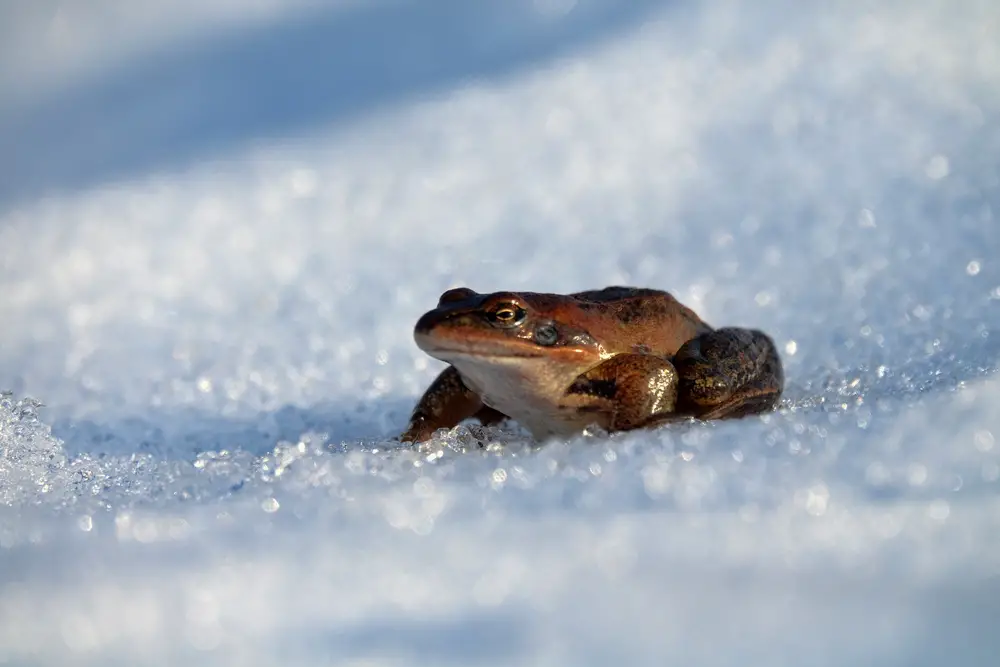
Where Do Frogs Go In The Winter?
When the weather turns cold, frogs know it is time to hibernate deep underground and underwater. They overwinter within the substrate at the bottom of the pond, lake or stream.
The water needs to have oxygen circulation in order for the frogs to survive. They breathe through their skin, absorbing oxygen from the water.
They spend the entirety of winter here until the warmth of spring calls them to swim back to the surface and live the warmer months swimming and enjoying life in the water and on land.
The Science Of Frog Hibernation: Slowing Down The Metabolism
How Does Hibernation Work?
Hibernation is an interesting process where they slow down their metabolism and enter a state of torpor. Torpor is when the animal can lower their body temperature to survive throughout the winter season and during periods of cold weather.
During this state, their heart rate and breath slows down. They are able to survive by absorbing oxygen through their skin. They are able to cool down and freeze their entire body. Some species in colder climates produce a form of antifreeze that protects their vitals while dealing with below-freezing temperatures during the cold winter season.
Frog vs. Toad Hibernation: Different Strategies For Survival
- Frogs: Hibernate in the substrate at the bottom of ponds.
- Toads: Hibernate under organic debris and leaf matter on the forest floor.
- Both species go into a state of torpor for the entirety of winter.
How To Create A Frog-Friendly Garden
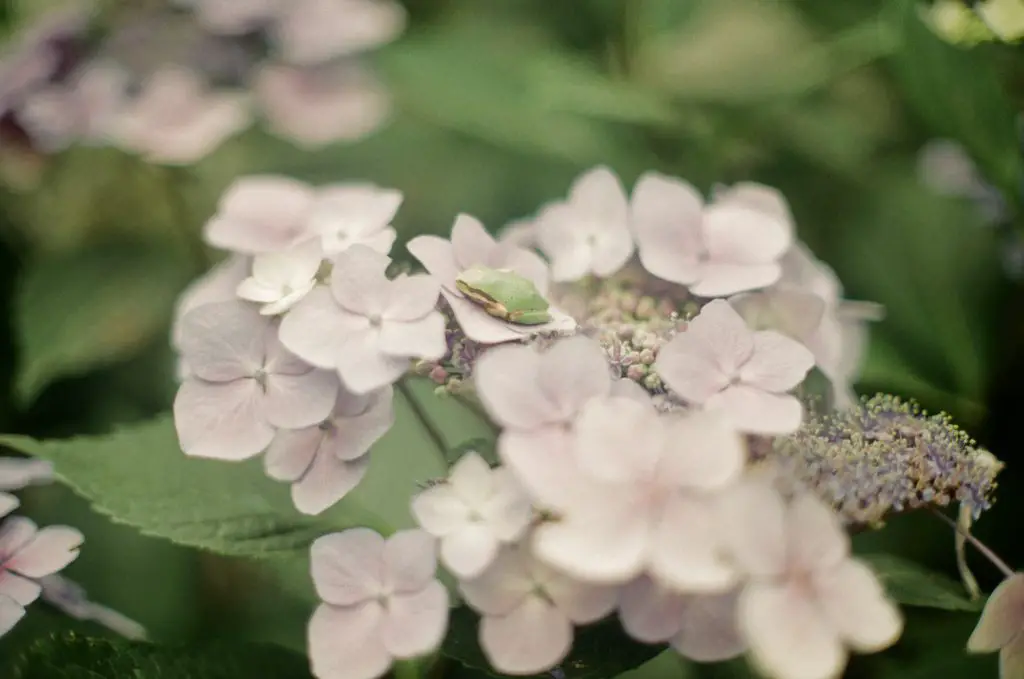
How To Attract Frogs To Your Garden
To create a frog-friendly environment and to attract them to your garden you require a couple of main habitat features. These include:
A Food Source
Frogs love insects and need to eat! To attract bugs to your garden choose pollinator plants that will draw in insects that will not only provide sustenance for frogs but also aid in pollination, building resilient plants and a biodiverse landscape.
A Water Source
Having a water source like a pond creates a beneficial habitat, as they are required to stay moist to survive. It is one of the most important features to include.
Aquatic Plants
Aquatic plants help to create shelter, aid in adding oxygen to the water, and more! Choose plants that create shade and shelter. This helps them keep cool in days of extreme heat and protects them from predators.
Below we will go into detail on what plants are best to add to your frog-friendly garden.
Best Plants to Attract Frogs to Your Garden
Dahlias
Tree frogs love dahlias. Every summer as I sit in the garden and look for critters, I always notice tree frogs nestled up into a petal cup of a dahlia. I have even seen 3 or more on one flower! If you have tree frogs in your area, try adding dahlias to your garden. It’s one of the cutest and most demure scenes I’ve seen!
Bergamot
Bergamot is a powerful pollinator plant. It attracts many different types of insects into the garden. These insects can provide lots of sustenance for frogs to eat!
Swamp milkweed
Swamp milkweed is a great perennial flower to add to your frog garden. These plants like moist soils and would do best surrounding the pond. They are beneficial pollinator plants. They draw in food for the frogs as well as monarch butterflies! These plants are beneficial for more than just frogs.
Aquatic Plants For Frogs: Shelter And Oxygenation
The Role Of Aquatic Plants
Choose plants that provide shade and shelter, thus providing a haven. Select plants that also help oxygenate the water and draw in a diverse amount of pollinators as a food source.
Some great aquatic plants include:
Water lilies
Water lilies look amazing in a pond setting. They also provide shelter away from predators and to stay cool on hot days.
Sedge
Sedge provides dense foliage, great for hiding from predators. They also make a great habitat for safely laying their eggs.
Pickerelweed
Pickerelweed has a beautiful purple flower that pollinators love. The foliage provides cover and their root systems help to oxygenate the water. This is a great plant to have in your pond!
Building A Pond: The Heart Of A Frog Habitat
Ponds are an integral part of building a strong and resilient frog habitat. A pond of any size will do if you are looking to draw them in. If you are looking to help them in all stages of life, the pond will have to have at least one area that is at least 3 ft. deep. This depth allows them to overwinter properly and ensures their safety.
Adding plants, including the ones we talked about above, helps create oxygen in the water and creates a more sustainable habitat for frogs and other critters.
How To Draw Frogs To Your Garden: Practical Tips
Creating A Balanced Environment
By including a food source, water source, and shelter you can create a balanced and healthy environment for them to thrive.
Toad Abode: Encouraging Toads To Hibernate In Your Garden
Toad abodes are a fun way to draw toads to your garden and keep them cool on hot days! They also create a perfect habitat for hibernation, keeping toads safe and cozy all winter long.
You can purchase a toad abode here, or easily make your own with a broken terracotta pot! Just turn it upside down, fill it with organic leaf matter, and make sure there is an entrance for easy access for the toad.
Frog Deterrence: When Necessary
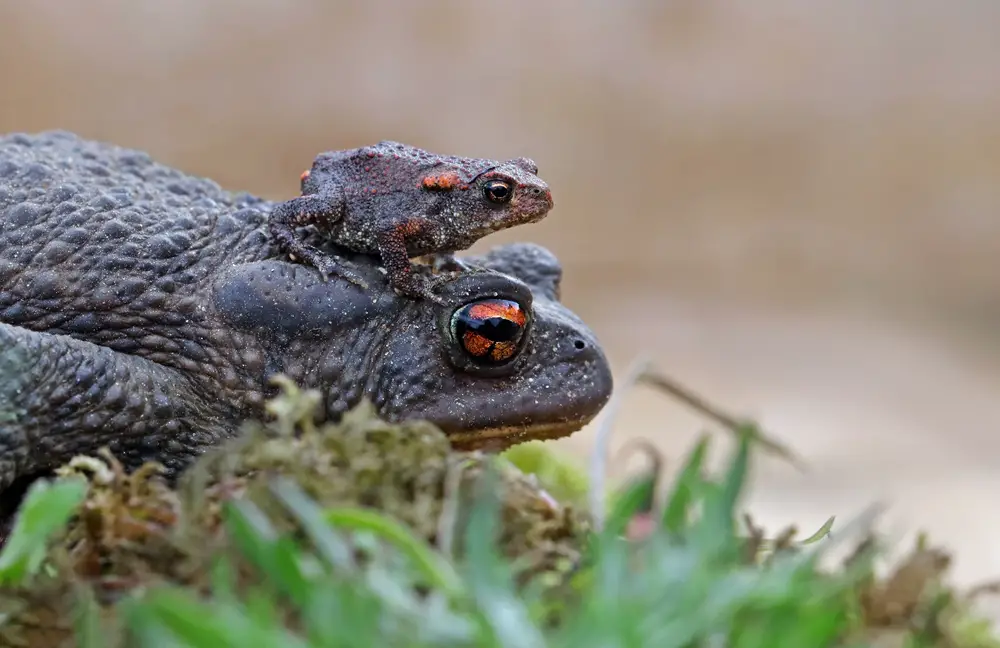
How To Get Rid Of Frogs – But Why Would You Want To?
Debunking Myths & Why Frogs Are Actually Beneficial To Your Garden
Frogs are a beneficial part of a thriving ecosystem. They are important in creating healthy ecosystems that help balance out insect populations. They won’t chow down on your veggies and they are awfully cute! These little critters ignite curiosity in children (one of my fondest memories is catching frogs in the garden)! And they are perfectly safe. It seems silly to ever want to get rid of these special amphibians.
Natural Ways To Deter Frogs
The first way is to change your mindset! These little visitors are only beneficial to your garden and ecosystem so don’t be concerned about them.
If you choose to deter them, please choose organic and humane methods. This can look like eliminating water sources from your garden and keeping your garden dry and free of organic matter.
Consequences Of Removing Frogs: Impact On Your Garden
Frogs help control insect populations. By removing them from your garden these populations can flourish. In particular, they love mosquitoes. You may see an influx in mosquito populations and other unwanted garden pests that can do more damage.
FAQs
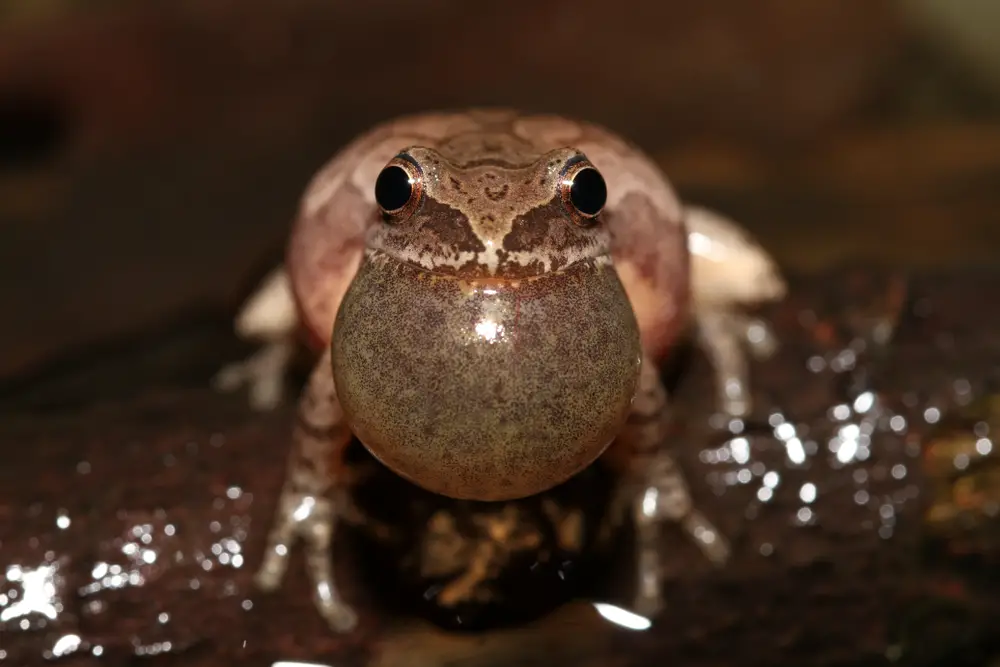
Are Frogs Reptiles?
No, Frogs are not reptiles, they are amphibians. Amphibians and reptiles’ closest relatives lived 250 million years ago. This animal was an extinct lizard called Seymouria. This lizard lived a terrestrial and aquatic lifestyle and had amphibian appearances.
Amphibians and reptiles are both ectotherms. This means they are cold-blooded and rely on external temperatures to maintain their internal body temperatures.
Do Frogs Have Teeth?
Some frogs have teeth, while others don’t. Some species of frogs have teeth on their upper jaw to grip food while eating. These teeth are short and pointy. Some species have fang like teeth, some species have no teeth at all. Toads do not have any teeth.
Throughout evolution, frogs have lost teeth over 20 separate times.
Can Frogs Give You Warts?
This is a myth! Frogs cannot give you warts. Warts is a virus that is only carried and contracted by humans.
Are Frogs Dangerous To Dogs?
In general, frogs are not dangerous to dogs but some toads can be.
All toads do secrete liquid that is poisonous but most species won’t affect your dog to the extent of being dangerous.
It’s important to note that two species of toads can pose a danger to dogs: the Cane Toad and the Colorado River Toad. Cane Toads North American range includes Texas, Florida, Hawaii, Louisiana, and Mississippi.
The Colorado River Toads range includes The lower Colorado River and Gila River, southern Arizona, and southwestern New Mexico.
These toads are toxic and can be very dangerous if ingested. Dogs and other animals can suffer from paralysis and even death if not attended to.
Symptoms of toad poisoning include:
- Increased salivation
- Foaming at the mouth
- Vocalization (whimpering, yelping)
- Pawing at the face or mouth
- Disorientation, stumbling, or circling
- Seizures
- Difficulty breathing
If you see your dog experiencing any of the symptoms, it is essential that you take your pet to the vet right away.

